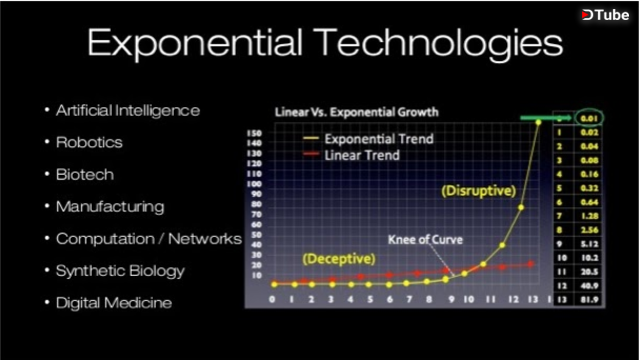
Beware the Kodak moment, warns Peter H. Diamandis in this exclusive video for the World Economic Forum. Entrepreneur Diamandis - co-founder and chairman of Singularity University (SU) - says we all need to wake up to the potential threats and opportunities of disruptive technologies.
On the pace of change
“My goal is to give you a sense of the pace of change. We haven't seen one percent of the rate of change that we going to see within the next ten years. It used to be that a thousand years ago, the only people who could change a nation or a region of the world were the Kings and Queens. One hundred years ago it was the industrialists, the robber barons, that could make the change.Today it’s anyone…”
“Anyone passionate enough is given access to these accelerating exponential technologies, and can take on the world’s grand challenges and, I believe, solve them. These technologies are the levers to impact one billion people. We cultivate at least 15 startups a year out of SU. An entrepreneur can actually start a company that impacts one billion people in a decade. At Singularity University, we teach: “If you want to become a billionaire, help a billion people. The world’s biggest problems, are the world’s biggest business opportunities.”
On the Kodak Moment
“We grew up with Kodak being one of the mainstay brands of the world. In 1996 Kodak was at the top of their game. It was a 28 billion dollar company with 140,000 employees that 20 years earlier had invented the digital camera, but failed to see the potential of it. In 2012 Kodak declares bankruptcy, effectively disrupted by the very technology that they had invented. They didn't understand what exponential growth would look like.”
“What’s interesting is that in 2012 Instagram gets acquired by Facebook. They’re also in the digital image business, but they've got 13 employees with a one billion dollar valuation. The difference between what is an exponential company and the linear one is this kind of disruption. I call it the new Kodak moment.”
On Democratising Knowledge
In 2010 the average computer was calculating at 100 billion calculations per second, which is more computational power than we had in the entire US Space programme in the 60’s and 70’s. In 2023, eight years from now, the average thousand dollar computer that you will go down to the store and purchase is calculating at 10 to the 16 cycles per second. That's just a number unless you speak to a neurophysiologist who tells you it's the rate at which your visual and auditory cortex does pattern recognition. So what happens when a thousand bucks buys you the computational power of the human brain? 25 years later a thousand dollar computer will buy you the computational power of the whole human race.”
“We’re heading towards a trillion sensor economy where effectively you’re going to be able to know anything you want, anytime you want, anywhere you want. These technologies are democratised technologies - they’re accessible to almost everybody. So a kid in Mumbai on a smartphone, has access to more cloud computing power than the chairman of MIT had twenty years ago. And more access to knowledge and information than President Clinton had twenty years ago. It’s an extraordinary democratisation that’s going on.”
▶️ DTube
▶️ IPFS
Hi! I am a robot. I just upvoted you! I found similar content that readers might be interested in:
https://www.youtube.com/watch?v=vlCb-1NM8mY